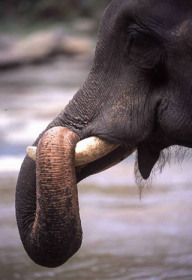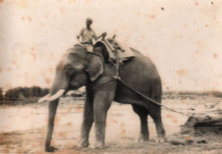Saving the Asian Elephant
(ASIA TIMES) Almost everywhere it survives, the wild Asian elephant is under threat. As human populations grow, its habitat is shrinking, and a thriving market for illegal ivory fuels a deadly trade in poaching. No one knows how fast Asia's remaining population of 50,000 elephants is declining -- but one of the most promising places for its survival is Myanmar, conservation experts noted at a recent conference.
A promising future in Myanmar?"Myanmar has the largest second-largest population in Asia, after India," said Raman Sukumar, chairman of the Asian Elephant Specialist Group (AESG). "And it has the potential to have a much larger population in the wild than it has at present. The extent of elephant habitat is probably the largest in Asia; we estimate that Myanmar still has about 100,000 sq km of habitat for the elephant, while the population is only between 5,000 and 6,000. You can compare that with India, where there is only about 80,000 sq km of habitat for 25,000 elephants. With proper protection and conservation methods, Myanmar could increase its wild elephant population."
Some fifty Asian elephant specialists gathered in Yangon early in February for several days of talks on everything from "resolving conflict between man and elephant" to "ultrasonic guidance of artificial insemination in Asian elephants." But the focus of the AESG meeting -- the first to be held in Yangon -- was on finding ways to help Myanmar rebuild its elephant population.
While it faces similar problems to other developing countries, Myanmar's isolation for much of the last three decades, its still relatively untouched forests and its tradition of using captive elephants in the forestry industry have all created the conditons for boosting the number of wild elephants.
Key to that, said analysts, is setting aside enough land for them to flourish. "If you look at the elephant distribution in Myanmar, you can see that there are distinct elephant populations, and they're isolated from each other. On the other hand, unlike in most countries, the habitats are still contiguous," said Sukumar. "What's important is to start setting up elephant sanctuaries in different parts of the country."
That's already starting to happen, according to Myamar elephant conservationists. Five sanctuaries have been proposed: Two in the northwestern Rakhine State, one in the central Bago Division, one in the northern Kachin State, and one in the southeastern Tenasserim region.
"Gradually, depending on availability of funds and expertise, more ranges will be included in the network," said U Uga, director of the Nature and Wildlife Conservation Division of the Myanmar Forestry Department.
Elephants have worked with man for centuries
Efforts to protect Myanmar's elephants go back to 1879, when the Elephant Preservation Act was passed. Culling and humane capture operations were allowed after serious crop raids by elephant herds in the early 1930's, but in 1994 elephants were given complete protection under the Protection of Wildlife Act.
Myanmar's elephants "range across a large expanse of the country, as our natural forests provide them with adequate habitats and sufficient food," said Minister for Forestry Lt-Gen Chit Swe, noting that the country was implementing a policy of "sustainable management" of its forests. Some fifty percent of the country is still forested, he added.
But real problems remain, often brought on by economic growth and the expansion of urban and cultivated areas. "Most of the habitats are considerably disturbed," said Ye Htut, warden at Myanmar's Meinmahla Wildlfe Sanctuary. "In certain areas, most of the regular movements have now been checked by a broad intervening band of cultivation, dams and other developments." Illegal logging and encroachment into protected forests are also problems, observers say.
A key concern is how to find ways to preserve the interests of both humans and elephants. More and more serious conflicts are being reported, especially after elephants have been driven into new habitats that cannot support them. Elephants killed 13 people in Myanmar last year, although eight of the deaths were caused by one rogue bull.
Moreover, poaching continues -- not just for ivory, but for meat and skin as well. Experts at the conference noted that poachers used snares, poisoned spears, pitfalls, guns, hunting dogs and even pesticides to bring down elephants. Others cited lack of environmental awareness, ineffective law enforcement, lack of funds and the international border trade in endangered animals as contributing problems.
Those are threats faced by the African elephant as well, and there has been strong international concern over their fate for years. In 1990, the Geneva-based Convention on International Trade in Endangered Species (CITES) made it illegal to traffic in ivory, in an effort to end the poaching of wild elephants. It is estimated that there are currently some 500,000 elephants left in Africa, half the number from a decade ago.
But Asian elephants differ from the African species in two key ways. The first is that only male Asian elephants have tusks. And the second is that for centuries, Asian elephants have worked closely with man in the logging industry. Thousands of elephants help extract millions of dollars' worth of logs from Myanmar's hardwood forests every year, and make up an integral part of one of the country's most important industries.
"How they manage the captive elephant population holds the key to the survival of the wild elephant population," said Sukumar. "The Myanmar Timber Enterprise has about 3,000 elephants, and they need to maintain this number to sustain operations at the currrent rate. But the captive population has been going down, so they've had to capture wild elephants to replenish their stocks."
Forest management is keyWhile most elephants have never bred well in captivity, he said, with a few corrections in their management, Myanmar could lower the death rate, increase the number of females, increase the birth rate slightly and achieve a sustainable balance, without having to capture wild elephants. "That's an important aspect of conserving wild elephants," Sukumar added.
Moreover, proper forest management can actually create areas that are better for elephants than untouched areas. "Unless the habitat is completely lost, in terms of clear felling, it doesn't necesarily effect the elephants," said Sukumar. "Elephants tend to thrive in secondary forests."
And as they have in Africa, elephants could come to be seen as a natural tourist attraction. Several teak camps are open to tourists, where visitors can watch the elephants work with their handlers, known as oozies. One observer at the conference noted that opening work sites to tourists could have an important beneficial effect, adding, "it's an experience many people wold cherish."
Others agreed, and noted that there was little time to waste. "Solutions rest with us, not with the elephants," said one participant at the conference. "We need answers to the problems before we reach a point of no return."


Reader Comments (1)